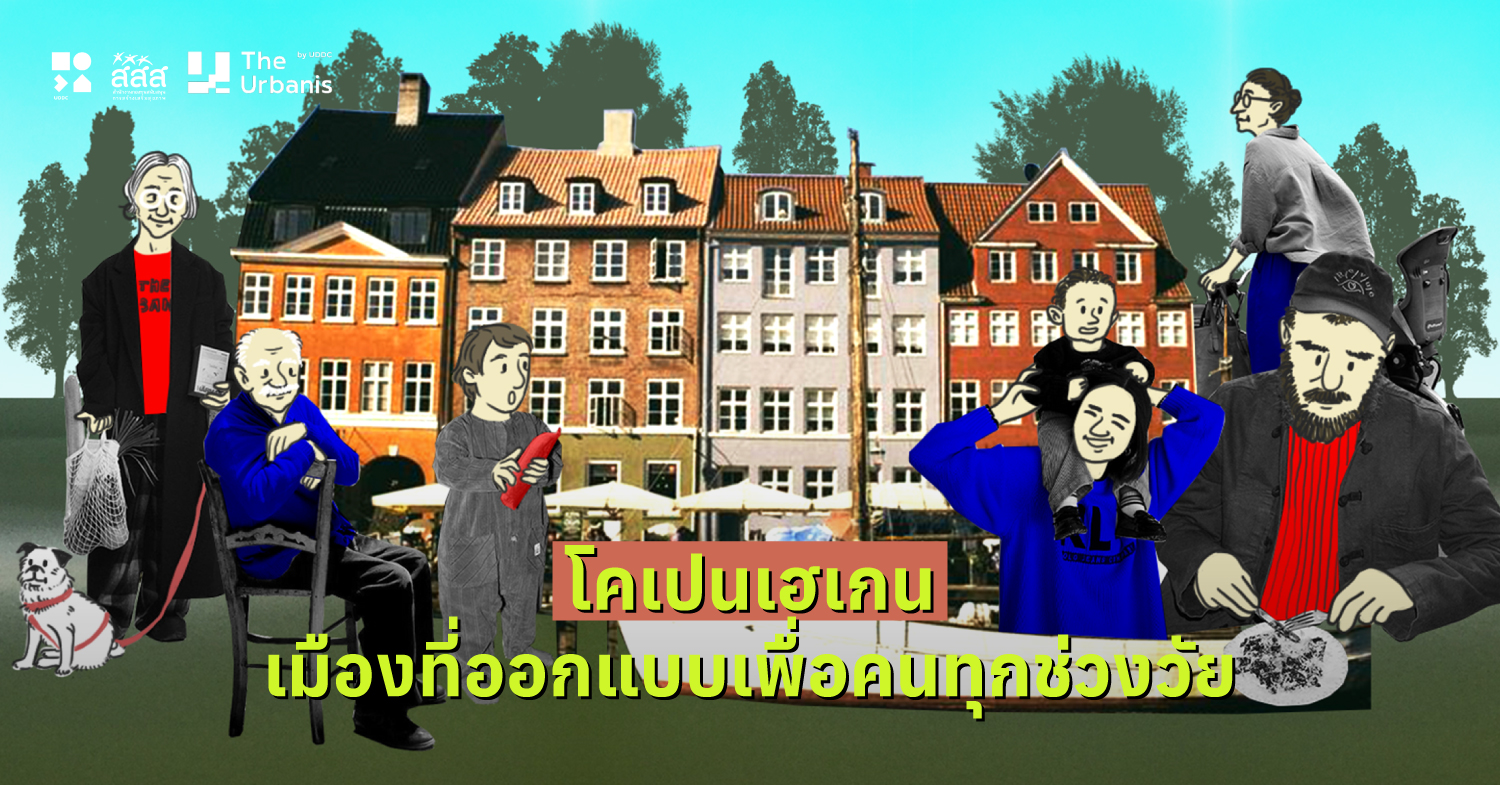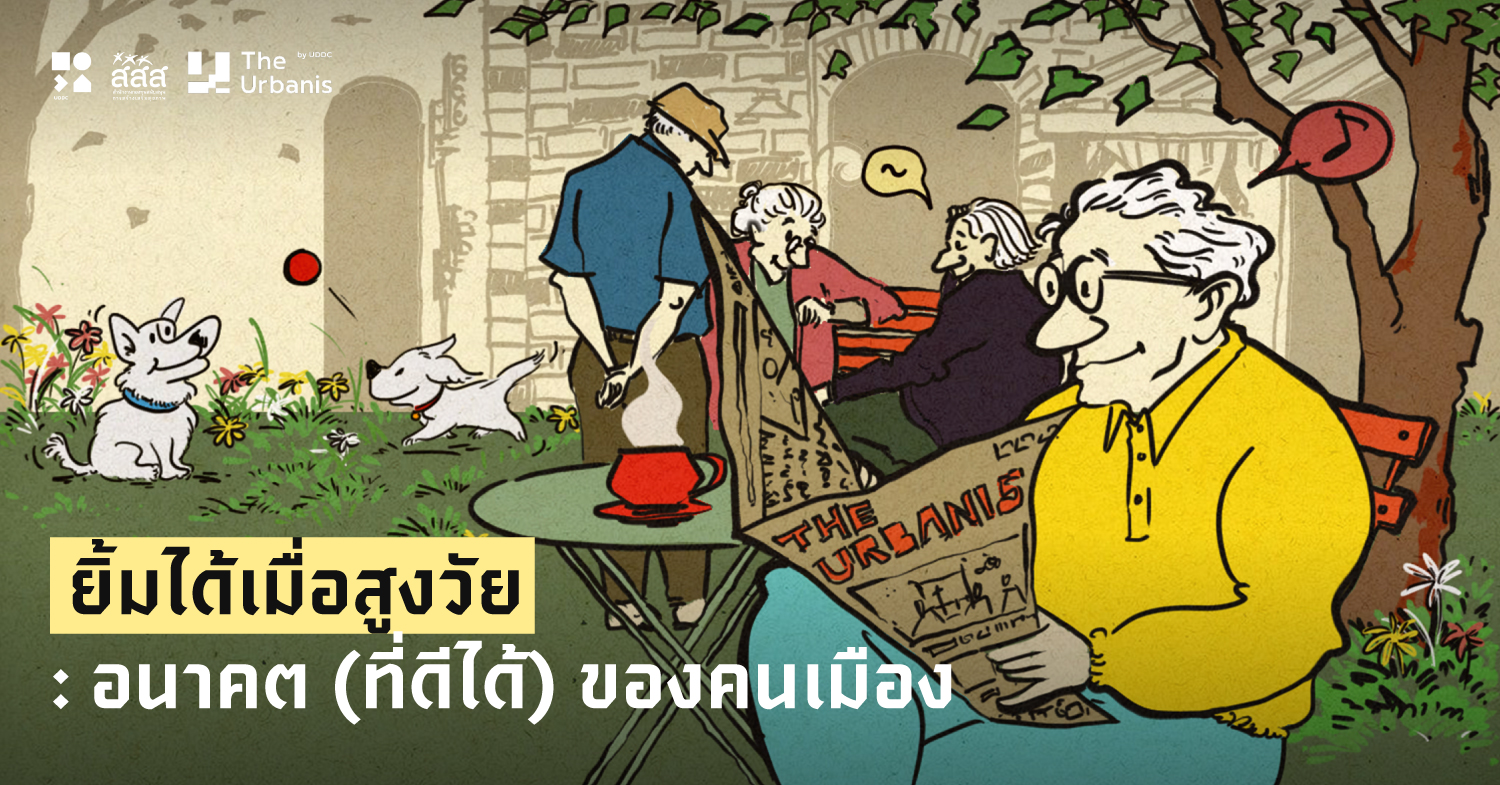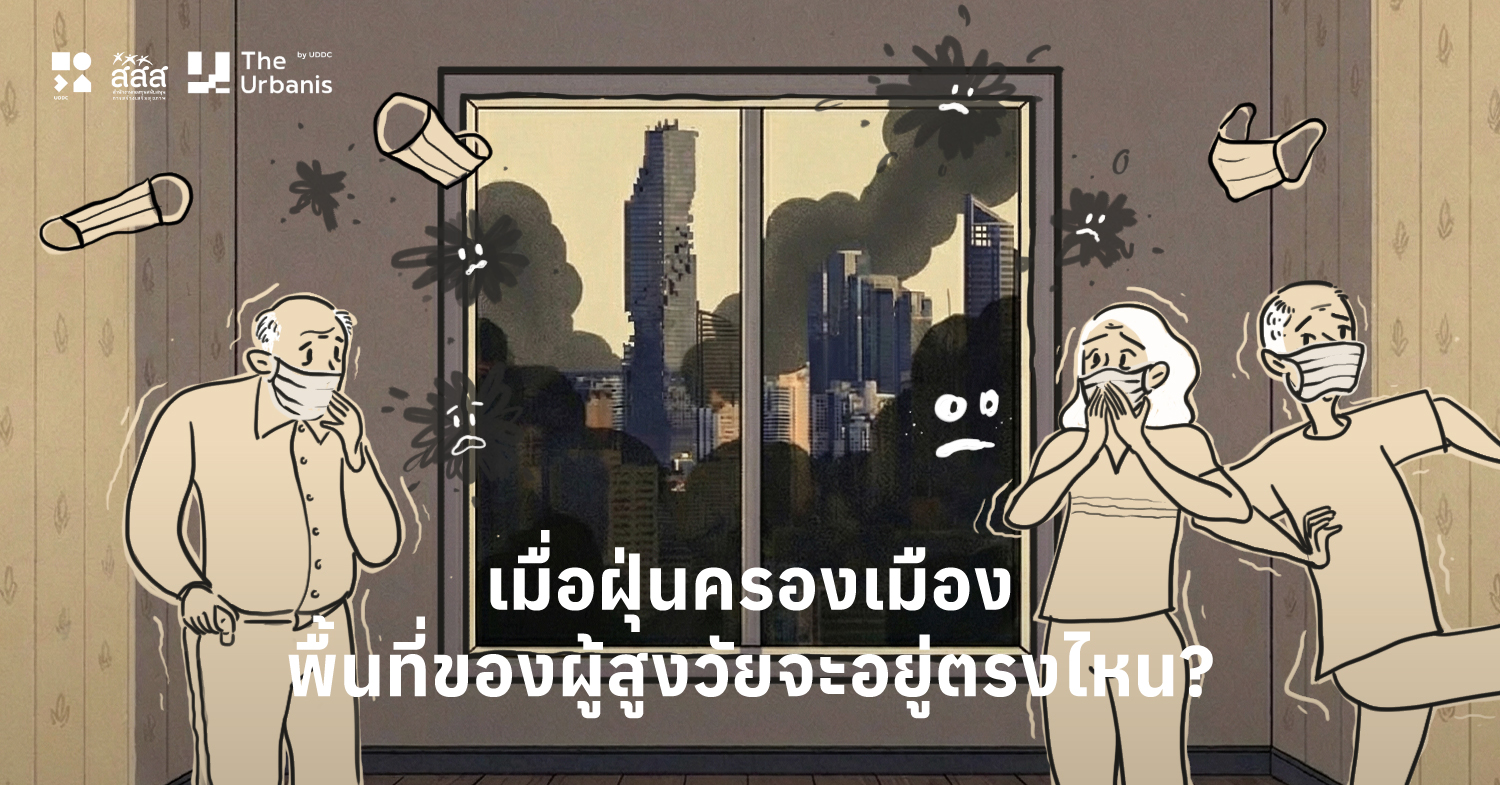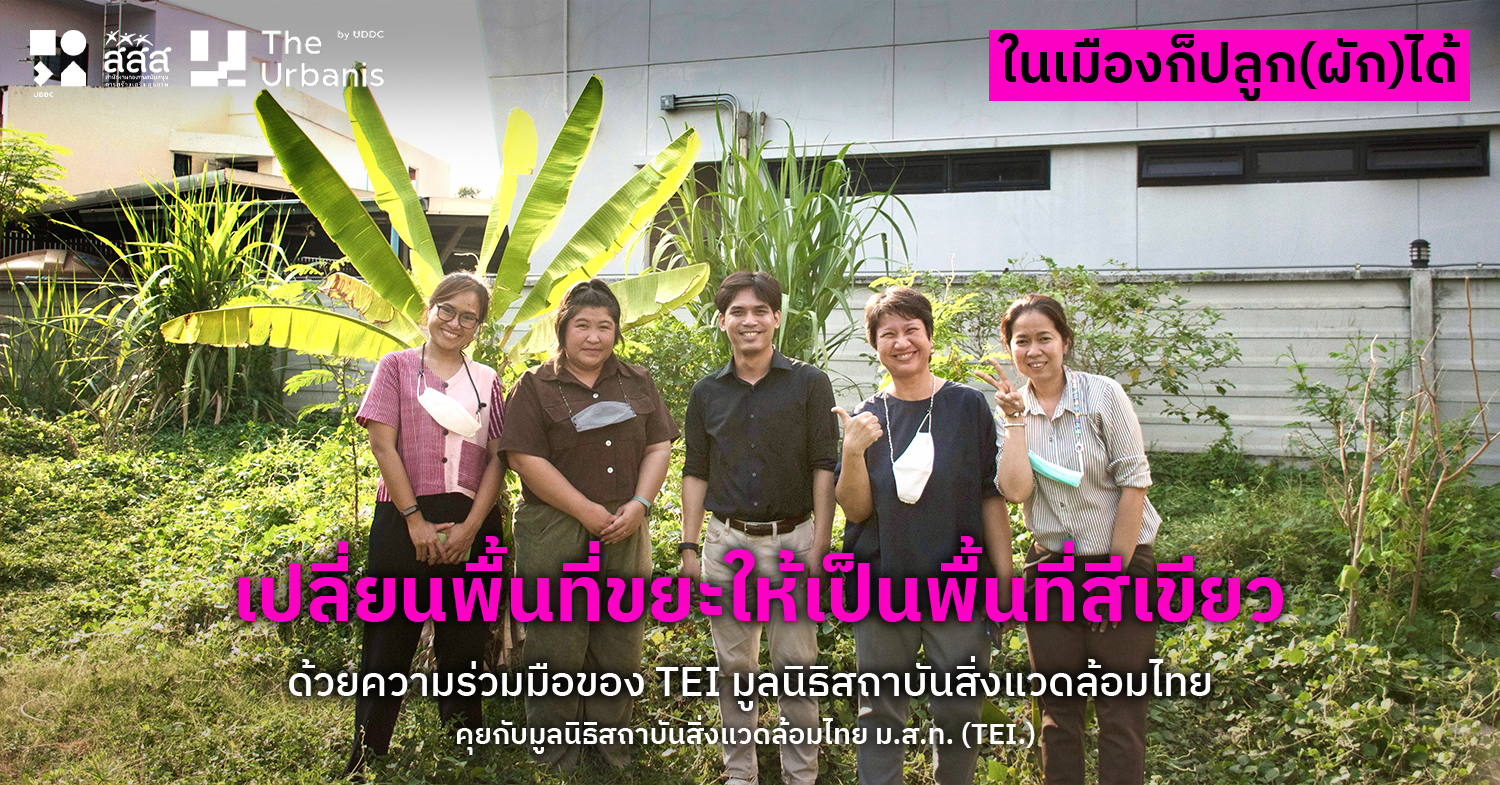16/09/2020
Economy
From the Financial Bazooka to the City Planning Bazooka: Proposal to Restore a Sustainable Economic Foundation
รศ.ดร. นิรมล เสรีสกุล อดิศักดิ์ กันทะเมืองลี้ ปาริษา มูสิกะคามะ ปรีชญา นวราช ธนพร โอวาทวรวรัญญู

Asst. Prof. Dr. Niramon Serisakul, Adisak Guntamuanglee, Parisa Musigakama, Preechaya Nawarat, Thanaporn Ovatvoravarunyou
3 dimensions of the urban response to COVID-19
This article is a proposal for urban design and management, produced by the Urban Design and Development Center (UddC) to emphasize that, for Bangkok, the present time is an opportunity to advance equality and fairness to everyone, especially the opportunity to make a living and pursue a career.
This opportunity has arisen due to the situation of COVID-19 which has affected nearly every society around the world and at the same time. More than ever, people are realizing how we are all connected – physically — and this has led to some irrational paranoia about contagion, as well as irrational behavior in ignoring the threat. However someone reacts, the pandemic is changing lifestyles in ways that are have massive economic impact. In particular, COVID-19 is impacting on consumption, as the containment effort is approaching the six-month mark. How we cope and adapt to this challenge can be assessed from three dimensions: Public health, finance, and consumption/occupation/income.
The control of the spread of COVID-19 in Thailand continues to progress well, and Thailand ranks at the top of countries in the world for its aggressive and (apparently) effective effort to contain the spread of the virus. Many people are citing the expansive public health measures implemented in Thailand, including wearing of masks, social distancing, and lock-downs.
However, there is some concern that the containment may have choked off key segments of the society and economy, in ways that may make it hard to recover. The government has tried to provide some stop-gap assistance to mitigate the economic impact of the pandemic, such as the 5,000 baht cash subsidy, and special assistance to farmers. This can be considered the financial dimension of the response to COVID-19, or collectively known as the fiscal and monetary measures.
Going forward, the third dimension of the adaptation to COVID-19 promises to be the most critical, namely, consumption, occupation, and income. This is the economy at the micro level that has to be revived somehow to avoid a relapse into economic recession that was last experience in 1997.
According to the Thai National Statistical Office (NSO) and WIEGO, which conducted a survey in 2018, Thai workers in the informal sector account for more than 55.3% of the total workforce, or about 21.2 million people. In urban and metropolitan areas, informal workers comprise up to 42%, of which 30% are non-agricultural workers, including the informal workers in the services sector in Bangkok (National Statistical Office, 2018)
Bangkok is therefore a magnet for many of these informal-sector workers. These include home-based workers, domestic workers, motorcycle taxis, mobile vendors and myriad others, totaling more than one million people. Although these informal groups of workers are the driving force of the economy, they are also the first to suffer from income fluctuations, sources of instability, and other externalities which means they live on the margins of poverty. These workers often perform labor-intensive jobs, but receiving low compensation. Most informal sector workers are at risk of periods of forced unemployment, while others work in unsafe conditions, or are exposed to toxins or pollutants (TDRI, 2020). Yet this vulnerable population is vital to the functioning of the society and economy in Bangkok and, therefore, they need special protections and stimuli in times of downturn or disaster.
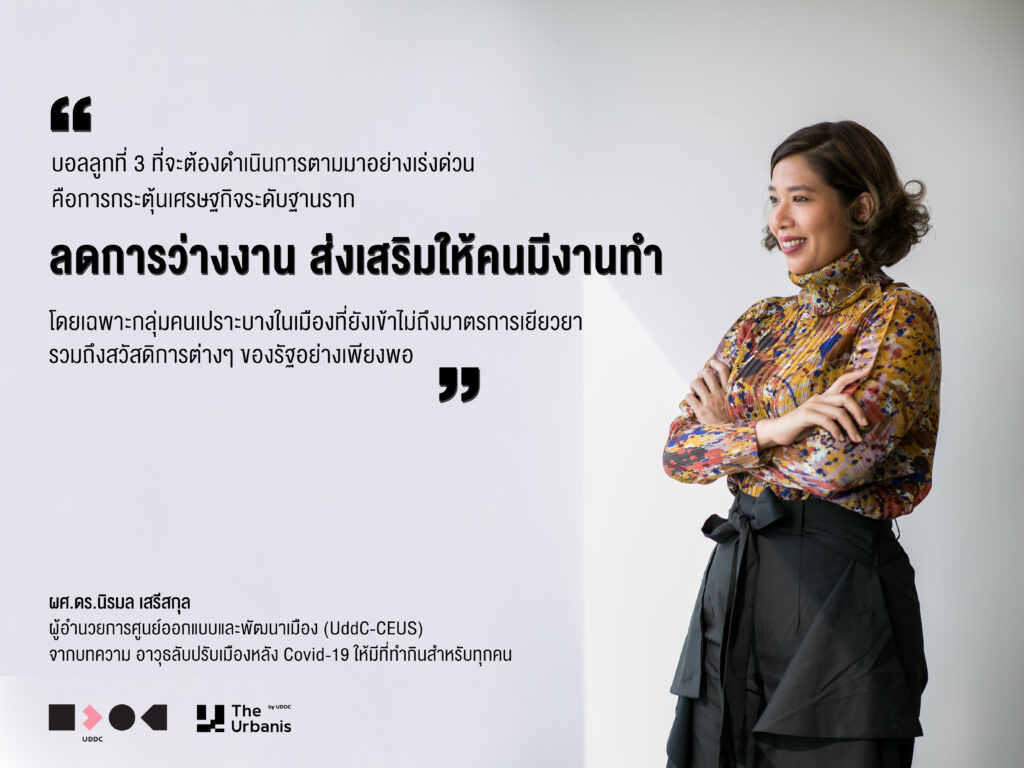
UddC and the Network of Academic Parties which consists of town planners, city planning architects, geographic information specialists, urban sociologists, and social workers. This group would like to present an example of the concept of revival and stimulus to the economy at the most basic level as a way to help and support the workers in the informal labor sector so that they can continue driving the national economy while strengthening their own livelihoods during this fragile time. This article uses the case of hawker trade and mobile vendor stalls.
Hawker stalls with economic recovery and urban consumption
Street trader or hawker vendor, is a career that can be said to occur in tandem with the growth of the city. In Thailand the expansion of the hawker vendors began in the beginning and middle of the National Economic and Social Development Plan process. Those plans first addressed the low-income situation of subsistence farmers in combination with the opportunity to create better income in big cities such as Bangkok (Narumon Nirathorn, 2017). Over time, hawker or street vendor became a viable career, and became a sort of curb-side department store as a place to peruse and buy household necessities, food, snacks, or drinks. The effect was to attract locals and tourists to these vibrant parts of the city and, taken as a whole, are a significant driver of the Bangkok economy – or at least until COVID-19 struck.
However, the hawker stall lifestyle is like a double-edged sword. During the expansion of Bangkok, the city grew without direction or guardrails. So too, was the expansion of the hawker stalls that lacked any form or organization or control. In some areas of the city, hawker stalls were so numerous that people could hardly use the sidewalk. Some stalls were also a barrier to road traffic. Being so close to air-polluting motor vehicles caused concern that vendor food would be contaminated. Some saw the hawkers as encroaching on public space that all people need to share. Still, people admitted that the hawker stall filled an important gap for consumers in a busy and bustling city such as Bangkok, and an important draw for tourists from around the world. Therefore, it became clear that there had to be a balance of opportunities and solutions by managing the hawker stall area and the merchant groups.
More conditions and constraints from the COVID-19 epidemic
In 2014, the government introduced the policy of “Returning the Pavement to the People” which included measures to control time and location for commercial use of sidewalks and pavement. This had the effect of dramatically reducing the population of hawker stalls (by as much as 70%). Then followed protests and organized groups of street vendors to petition the government to relax the crack-down on street trade. This led to a revision of the control measures and compromise solutions for a more orderly market for hawkers to operate.
Yet there is another consideration, namely, the perspective of pedestrians in everyday life who may have adversely affected by the density of hawker stalls on the sidewalks, but who also probably bought items on their way past. Plus, the hawker stalls and mobile vendors were probably playing a vital role in buffering the lower-income groups from the rising cost of living in Bangkok. According to a study by Women in Informal Employment: Globalizing and Organizing-WEIGO in 2018, the loss of more than 70% of the hawker stalls in Bangkok caused the lower-income workers to incur a higher cost of living: By about 357 baht per month (which is the equivalent of having to work one more day each month).
This dynamic continued to be a matter of public debate with no clear conclusion. However, the advent of Covid-19 virus mandated stricter conditions for managing the area and activities of the street vendors. On the other hand, the urgency of the response may be an opportunity to resolve the hawker issue with the city administration to achieve a sustainable and peaceful coexistence.
In the “twin worlds” of the hawker stalls in the city
Tim Cresswell is an academic who has proposed “geographical ways of thinking” or the study of looking at the world through a physical perspective. Cresswell contents that conflicts in any physical area happen not just because there are many people together, but because each group of people has different understanding and image of that area, including what it is and how it should be (sense of place). This perspective is shaped by the way of life, work, and the use of the city by individuals, when each group has a different agenda. Naturally, when there exist different ideas for managing different areas, conflict is inevitable. The same is true with the hawker conflict. The hawker market stall also has an image of the city. They certainly view the public spaces and sidewalks as providing commercial benefit. Alternatively, pedestrians will view those same spaces as a public right of way to get from Point A to Point B, safely and conveniently. Thus, despite their mutual dependence, street vendors and pedestrians are inextricably linked in this dynamic tension.
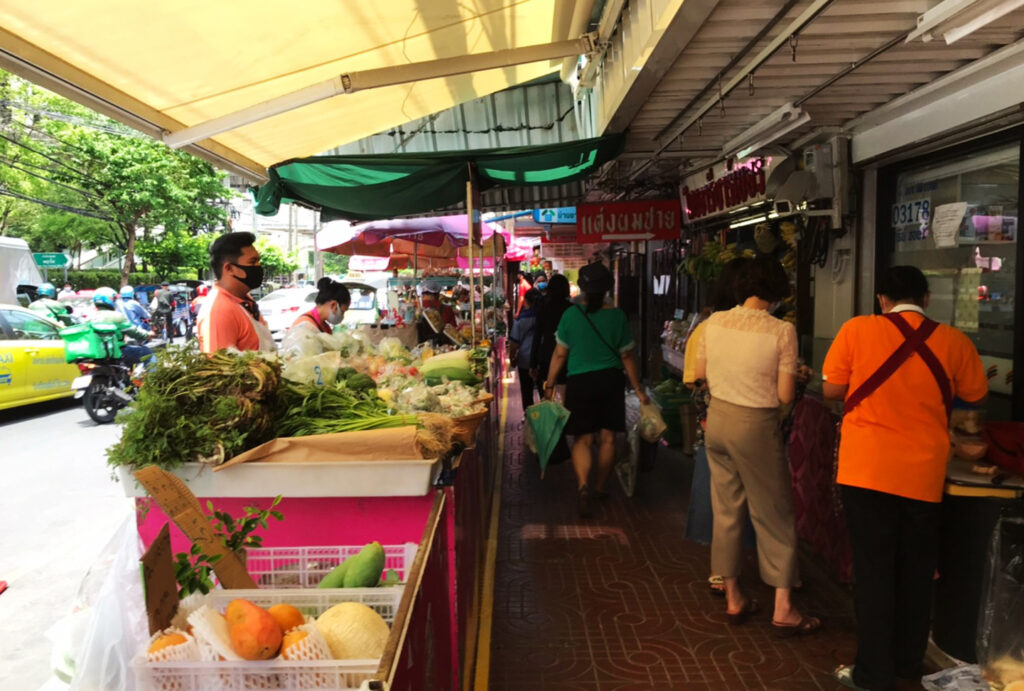
Street vendors around Soi Aree 1

Street market in Bang Khun Tian 69
Before addressing its spatial proposal, the UddC-Urban Insight team would like everyone to know more about the hawker stalls around the city. The truth is that these stalls are not everywhere, but only in specific locations. Thus, it is important to understand what are the basic needs of the street vendor, and what would a sustainable solution look like.
The location of the town morphology and hawker stall
Data from the Hawker Stall database of the Department of Law Enforcement of the BMA in 2018 were compiled and synthesized by UddC through the Open Data for a more Inclusive City project. Previously, there were over 667 street market areas throughout Bangkok, including a total of over 19,000 stalls, carts, and mobile vendors covering a linear distance of over 100 kilometers. The latest information from the BMA is that 175 street market areas are continuing to operate during the COVID-19 containment period, or about one-fourth of the pre-COVID number. Other sites are being demolished or repurposed.
Considering the site and situation and spatial distribution of the hawker stalls, there are significant characteristics of the location which allow the classification of stalls into four types, as follows:
Type 1: Hawker stalls located within a radius of 500 meters from a fresh market or weekly market zone. These stalls are actually an extension of the market which expands the food options of the public.
Type 2: Hawker stalls located around work sites or educational institutions which implies these areas are regular urban destination of persons in the city.
Type 3: Hawker stalls located in the nodes of the major traffic intersections areas of the city en route to residential zones in the periphery of the city.
Type 4: Hawker stalls in densely-settled residential areas and multi-purpose buildings.
In addition, when overlaid with the ‘walkability’ map or the city pedestrian map, it was found that over 95% of the stall locations are in a walkable area (see the green area in the map below and read more at www.goodwalk.org). The location characteristics reflect the relationship between walking areas, also referred to as a neighborhood which is defined by the distribution of hawker stalls. This synergy can be considered as the basic requirement of the location of the hawker trade stalls, which is a busy area for people and activities, and has a critical mass of foot traffic. Thus, the paradox is that the street vendors are both an attraction and the obstacle for pedestrians.
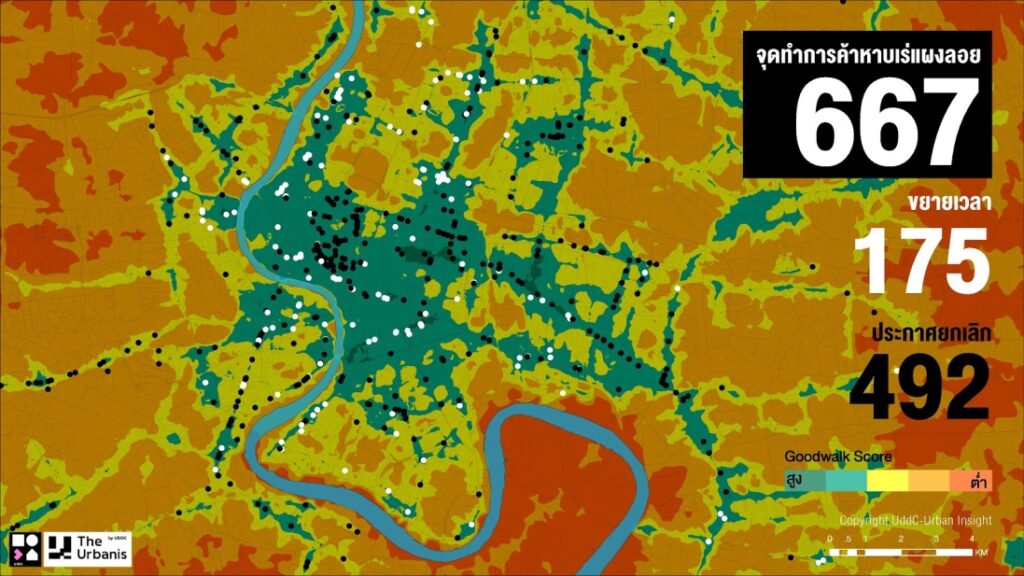
Without a basic understanding of these dynamics, attempts to manage hawker stalls — especially the proposal to move the stalls into artificial trading zones — will not be sustainable. That is because the current distribution and concentration of the stalls is defined by the natural movement of traffic and pedestrians (i.e., Movement Economy Process). Therefore, if the hawker stalls are viewed negatively as a source of conflict in spatial issues, then no viable solution is possible. Instead, the street vendors need to be seen as an economic resource that is a driving force for both the economy and the functioning of the city.
Bangkok has enough living space for everyone
We believe that Bangkok is big enough to accommodate everyone who needs to be there. In addition, the city needs must give everyone equal and fair opportunity, both from the perspective of the street vendors and from the perspective of pedestrians. Therefore, the UddC has created a proposal for the spatial design and management of the hawker stalls in Bangkok. This proposal be divided into two measures. The first is a makeshift response with a period of deferred action, and allowing street vendors to continue to operate in their natural conditions and environment, and in accordance with the spatial conditions specified by the BMA. The second part is long-term measures is to analyze and identify other potential areas of the city where hawkers could operate without encroaching on public walkways.
Interim measures to allow continued street trade on sidewalks
According to the conditions and spatial requirements as stipulated in the BMA announcement on “Rules, procedures, and conditions for determining commerce and sales areas or selling products in public places” dated February 28, 2020, as criteria for consideration of areas to be able to continue trading on the sidewalk with spatial conditions, and which can be divided into two types according to the potential of public roads and footpaths as follows:
Case 1: Allowing to trade in pedestrian areas with a width of 4 meters or more by specifying a public road that is not less than 2 meters and a buffer distance of 50 cm from the edge of the road, most of which are located on the road. Most of these locations are on main roads (principal/major arterial) and the secondary roads (minor arterial) with 4 or more lanes of traffic. From the analysis of spatial data, there are more than 101 hawker market areas that meet the criteria in Case 1 which account for 15% of the total trading points, and which can support up to 3,026 vendor stalls.
Sidewalks with a width of 4 meters or more are considered to be premium real estate in Bangkok. In accordance with the 2006 Urban Planning Standard, sidewalks in business-commercial areas, industrial areas, residential and school districts must be at least 1.5 meters wide, which means that pedestrians can pass by each other comfortably. The Department of Local Administration has standards for urban areas as detailed in the Road, Walkways and Sidewalk Standards Manual, specifying a maximum width of 3 meters for Level 1 roads, 2 meters for Level 2 roads, and 1.5 meters for Level 3-4 roads ) The survey of pavement width in Bangkok of the GoodWalk Project in 2015, collected data on the sidewalk width along over 1,000 roads around Bangkok, and found that the average walkway width is only 1 meter.
Therefore, this 4-meter wide footpath is considered a rarity, and it is large enough to fit other activities in addition to pedestrian traffic. That concept is in line with the idea of creating a road that is vibrant and interesting and, in fact, sidewalks in the city are considered a public area that can be more than just a footpath.
Case 2: Allowing to trade on pavements of 2.5 meters or more width in Collector Streets and Local Street which have light traffic. From the analysis of spatial data, it was found that there are more than 64 hawker market areas that meet the criteria in this case, accounting for 10% of the total number of trading zones.
When combined, these two interim measures could restore up to 25% of the hawker market areas or join over 165 trader zone with more than 4,738 vendor stalls.

Suggestions for pavement design guidelines for hawker trade stalls
In addition to the width of the pavement being more than 4 meters, there is also a framework for placing and designing vendor panels, as per the BMA announcement (Government Gazette, Volume 137, 28 February 2020) which has the following specifications:
• The stall must have a distance of at least 2 meters for public pedestrian walkways.
• Specify a buffer distance of 50 cm from the edge of the traffic for safety, and not having containers or clutter in that area.
• In the area around the Grand Palace, other palaces, and monuments within a distance of 150 meters, no trade stalls are allowed.
• Trade stall layout requires a 5-meter spacing for every 10 vendor panels in order to provide emergency access and allow convenience for pedestrians.
• Specifying zones classified products such as food zone, clothing zone, miscellaneous goods zone, etc.
• Set the receding distance from the vendor stall, bus shelters, stairs to mass transit stations to be at least 10 meters.
• Specify the buffer zone at the crosswalk area of 3 meters on each side to be the area where no stall is located.
• Specify the buffer zone at the intersection of 10 meters on each side so that there are no stall.
• Specify the buffer zone from the entrance to the building to be at least 5 meters.
• Specify the buffer distance for public toilets and the fire hydrants to be at least 3 meters, and 1 meter around the post boxes or telephone booths.
The results of spatial analysis in accordance with the above criteria can be used as a condition for designing and placing a hawker trade stall on a sidewalk. This is a compromise solution for the sake of pedestrians and street vendors. The UddC team has simulated such a design in two pilot areas of Bangkok that have the potential to meet the standards and criteria. The optimum dimension is a network with a width of more than 4 meters on the main road in Bang Khun Thian 69 and an area with a width of 2.5 meters from the secondary road in Soi Aree.

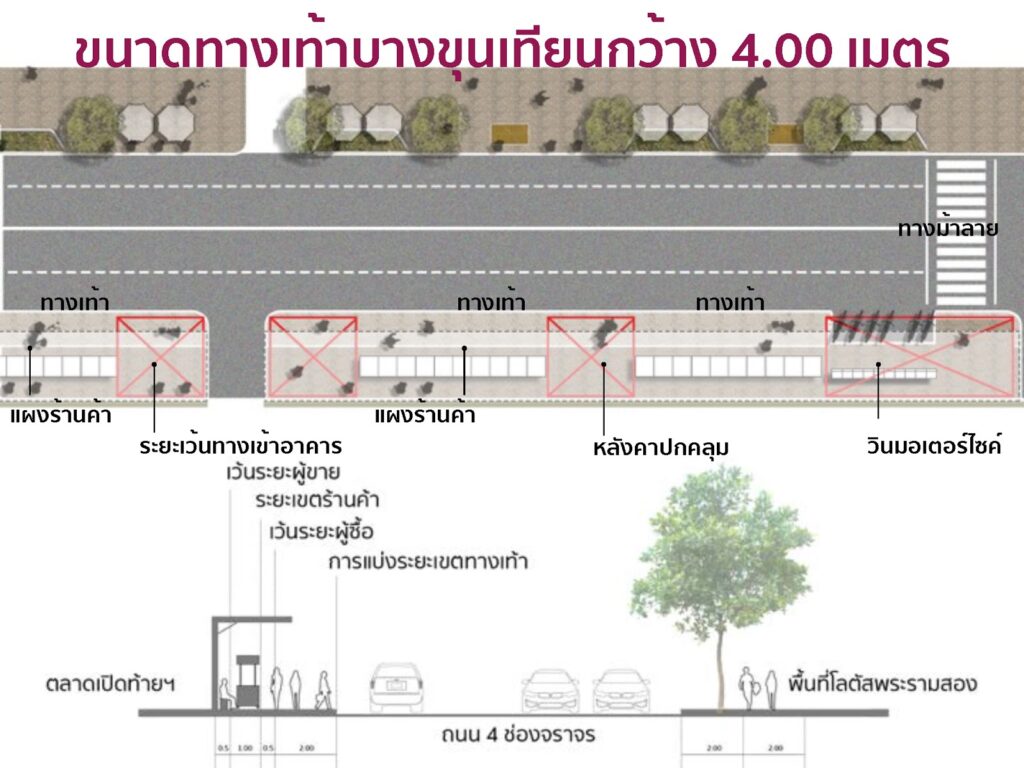
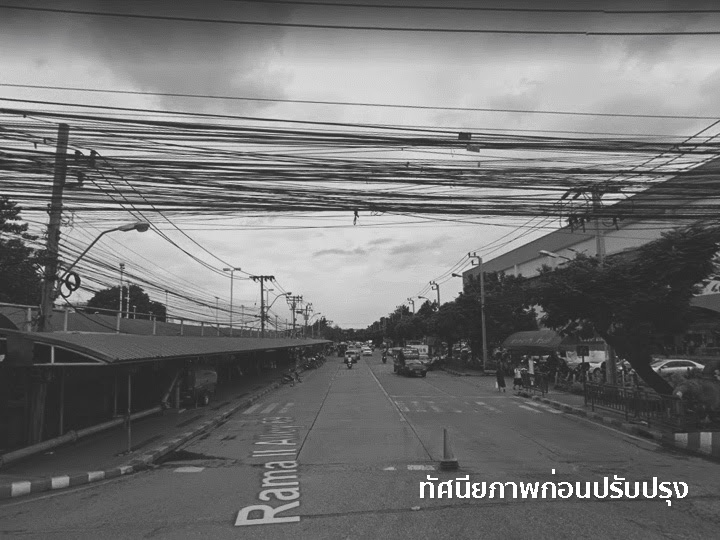
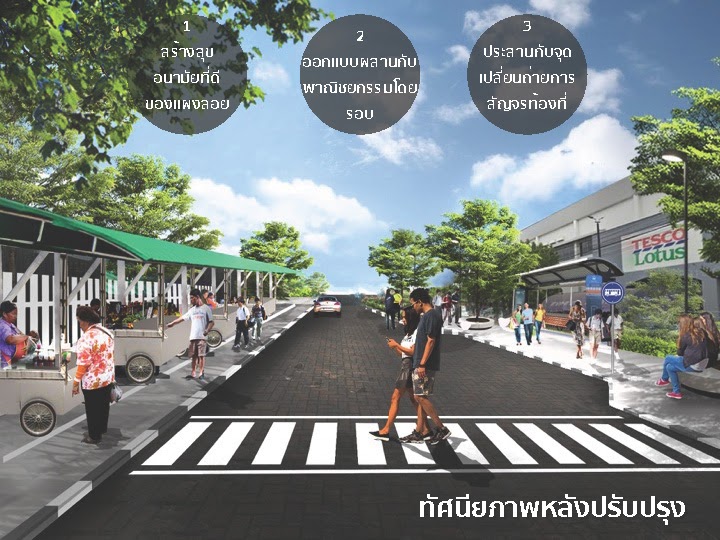
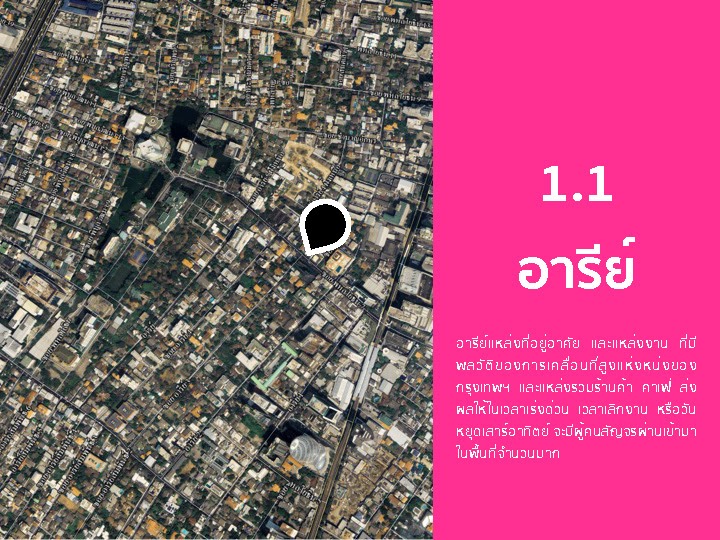
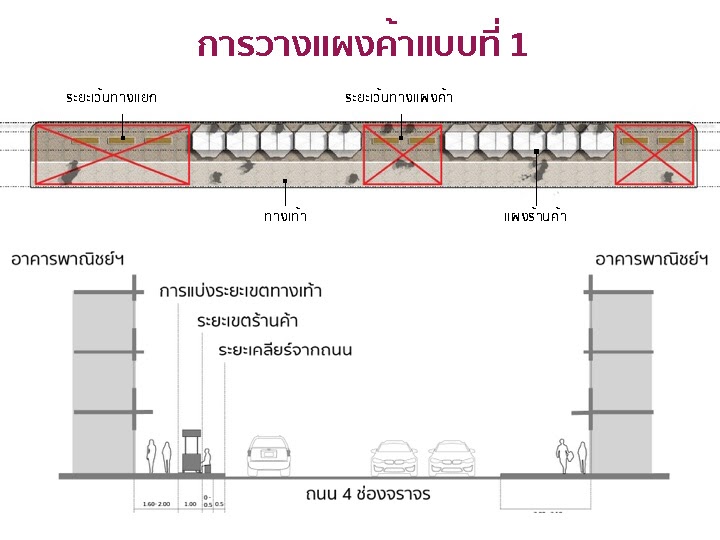
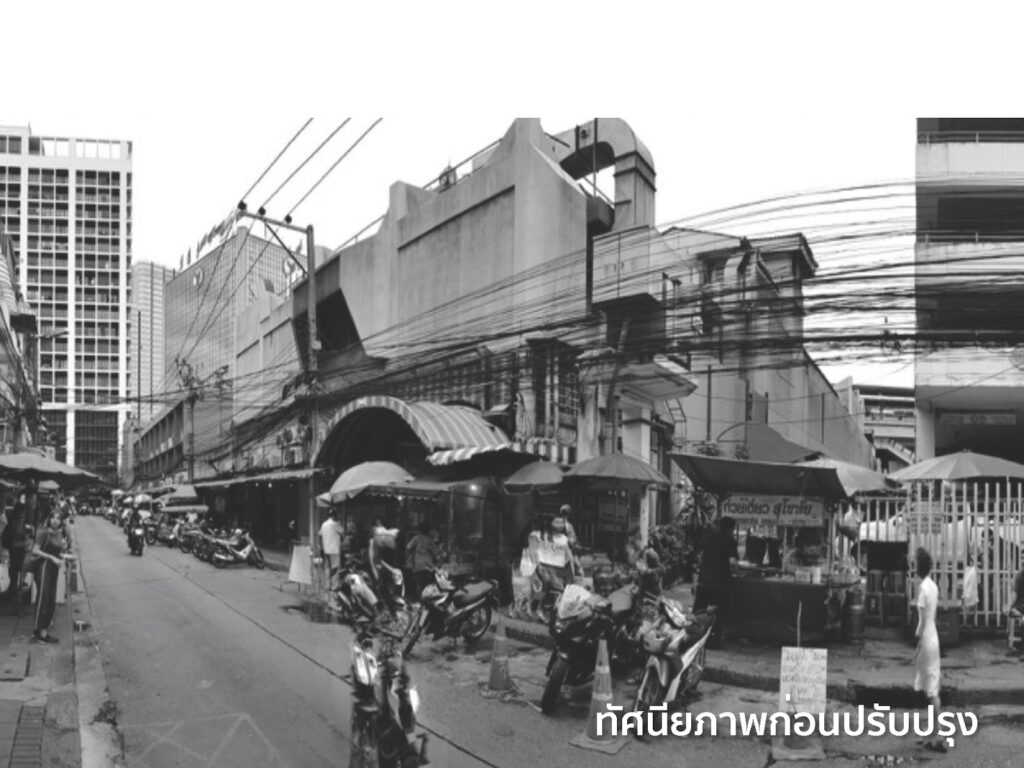
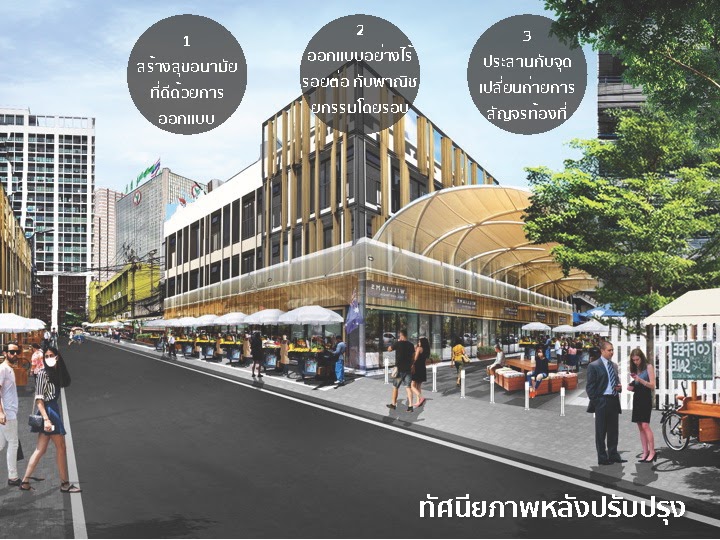
Plan and landscape of Soi Aree (Paholyothin Soi 7)
Long-term measures to promote the career and opportunities of the hawker economy
In addition to makeshift interim measures described above, which are considered permissible to allow street vendors on pavements that have widths as specified by the BMA, there is also the need for long-term measures to remedy the larger situation of hawker stalls affected by the cancellation of over 75% of street vendors in 492 trade areas. UddC considered proposals for sustainable government investment measures while revitalizing the city by reviving areas that are not fully utilized in the city, such as under the expressway, idle areas of government agencies, and other areas of various government agencies. This strategy aims to rejuvenate and improve the space design to support the hawker trade activities, thereby creating/continuing the opportunity to earn a living for less privileged residents of Bangkok. The proposal calls for a master plan for developing areas that are not limited to hawker trade stalls only, but also include a space change to expand public space, with inter-connections between the pedestrian and bicycle networks in the city center.
In the simulation of space requirements to support and rehabilitate those affected by the hawker crack-down policy mentioned above, the designers will consider the demand for space of the 492 affected stalls, totaling 14,158 panels, which require a total area of approximately 70 rai to accommodate all the vendors.
Some of these trading areas do not meet all the physical characteristics of the short-term measures (e.g., pavement width is less than 4 meters). That means a stall that cannot be traded on a pedestrian area. The stalls must also meet safety, cleanliness and orderliness conditions in order to make the sidewalk convenient and safe for pedestrians.
Returning to the supply side of the city area, there is a possibility to bring improvements to support such activities, namely the area under the elevated expressways in the inner city area, which has more than 600 rai. Aside from being able to be a space to support hawker trade stalls, those areas can be regenerated to connect the paths, networks, sidewalks, bicycle paths, etc. to increase the connectivity potential of the pedestrian network and traffic within the inner city area.
There is a minimum threshold of pedestrian traffic that a fixed hawker stall needs to have to survive. An important condition in determining the areas that are suitable to support and pinpoint the location of the hawker stalls is that those areas must have a sufficient amount of traffic of potential consumers. There are stories of relocating a popular street vendor to a new area, but which does not achieve the same level of consumers because of subtle changes in the environment that discourage trade. A key factor is that the hawker stall is located in a section of the street in which consumers move past the stall in both directions. It is also important for the street vendor to have a product that is unique in some respect. The vendor stalls must accommodate impulse buying as well as efficiency and convenience for the pedestrian on-the-go. Street vendors in the Yaowarat area of Bangkok’s Chinatown or Khao San Road have distinctive products which also reflects and uniqueness of those neighborhoods. In sum, the location that is suitable for being a hawker trade zone is that it must be an area with sufficient traffic volume and ease of access. These factors are easy to measure and map (which will be discussed in more detail in the next article).
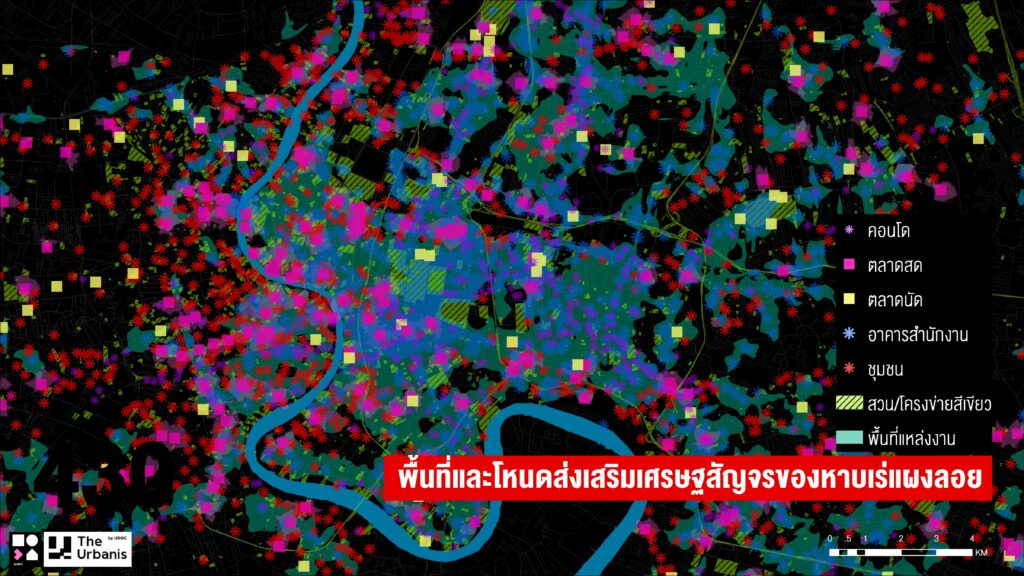
Map displaying traffic volume
In this application, the spatial analysis took into consideration the traffic quantity and ease of access by network analysis using geographic information systems. This enabled an assessment of the potential of the area under the elevated expressways that is suitable for hawker traders. The area under the Si Rat Expressway is particularly suitable, extending from the split Uruphong – Sathon Intersection And the area under the expressway at Phahonyothin 1, from Phaya Thai Phirom Park to the Victory Monument expressway entrance. Those zones comprise a total area of more than 130 rai, which is enough to support all 14,158 hawker stalls. The surplus area could be developed into a public area of the city as well. This is an example of a strategy to address multiple problems with a single solution.
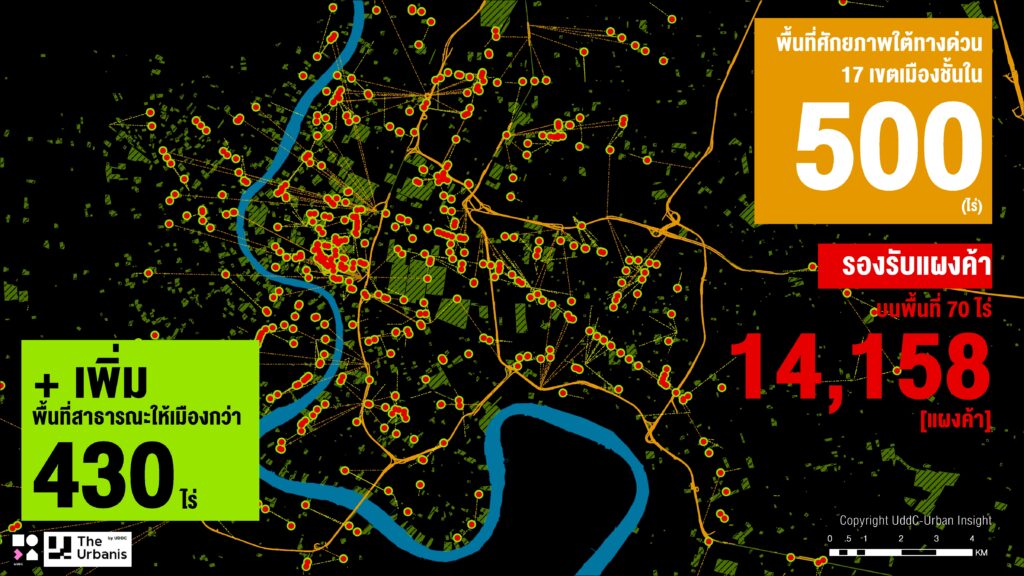
Areas with potential for development under elevated expressways
From a derelict area to a vibrant economic zone with job creation areas at the neighborhood level
One of the public areas that is part of the city but is not in use and those spaces under the elevated expressways. The original characteristics of this idle structure consists of enormous, dark, and stuffy spaces that create walls that separate people. They keep neighborhoods apart from each other when before they were connected. Both the lack of concern for the area and inertia could easily give rise to crime or gang activity. This creates a feeling of insecurity for those who have to pass by. But imagine how great it would be if these enormous amounts of free space were regenerated into an inviting public space that connects people and is an area to promotes well-being for the city. The following are five design concepts to achieve that vision.
1. Establishing a connection with the surrounding area: This approach can work whether it is a residential area, economic center, historic district, commercial district, government agency zone, tourist area, or creative district. The area can be repurposed into a seamless public space which creates social connections and becomes a place for recreation and increasing the well-being of urban people.
2. Building awareness in the area: This involves designing an area to connect in all directions and creating a space identity. There are bike lanes and sidewalks that lead to the activity area.
3. Creating vitality and feeling safe: This aim of this design is to ensure that the area has an abundance of activities and is actually used for constructive purposes by a variety of people. This design reduces blind spots and creates dynamics to revitalize the surrounding area. The crossing design is wide and pedestrian-friendly to reduce the role of cars. The area should only require minimum and easy maintenance, and have bright lighting at night.
4. Creating a feeling of common ownership: The area under the elevated expressway is not just part of a thoroughfare. It’s an area that creates shared experiences between people and creating new activities along the way.
5. Rejuvenation of the neighborhood: Create activities that are attractive, appealing, and relevant to the context.
Makeover of the area under the Uruphong-Sathorn section of the Si Rat Expressway to be an economic enterprise zone of the neighborhood, with bicycle paths connecting to other parts of the city
The area under the Si Rat Expressway that extends from the Uruphong intersection to the Sathorn intersection, covers a total distance of 4.5 kilometers in the inner city area of Bangkok. This area connects important neighborhoods such as residential areas in the Rama VI area, secondary to Hua Lamphong, Charoen Krung, and commercial areas of the city such as Sathorn-Silom, Bangrak, Si Phraya, etc. That location under the expressway is a strategic area of the city, there are people who live around and travel through the area. There are more than one million people traveling through this area representing the diversity and bustle of Bangkok.
However, at present, this area under the Uruphong-Sathorn section of the expressway is being used as a temporary cargo warehouse, garage, impromptu sports field, or derelict, unfenced area.
At the city level, inefficient or idle use of the valuable area is a lost opportunity of the city in order to stimulate the retail economy in the Central Business District (CBD). The desertification of the area under the expressway should be an embarrassment to city administrators and residents alike. Furthermore, leaving areas to become derelict like this fosters crime and a sense of danger or insecurity. It also becomes a breeding ground for germs and insect vectors of disease. In addition, these spatial structures function like barriers which cut off social interaction among neighborhoods.
UddC sees these limitations as opportunities for redevelopment and revitalization to become a new strategic area in the economy of the city. In accordance with the five design concepts mentioned above, UddC is spearheading a design program in a pilot area under the Uruphong-Sathorn section of the elevated Srirat Expressway. The area can be subdivided into the following purposes:
• The first purpose is embodied by at the intersection of Silom Road which provides a strategic portal to pedestrian paths and commercial street.
• The second repurposing envisions the area to host a flexible food market with shopping activities and tasting menus. In addition, during festivals, the area can host food exhibitions. Famous restaurants in the area can set up booths to sample their favorite dishes.
• The third concept is to create a safe and peaceful place to relax, sit, and enjoy access to a library (i.e., an urban relaxation pocket).
The Surawong Road section connects with Charoen Krung ‘old town’ residential area. There is the concept of planting small gardens or exercise areas to promote health in the neighborhood (i.e., an urban cultural pocket).
The Si Phraya section is connected to Bang Rak creative District to be a creative & learning space.
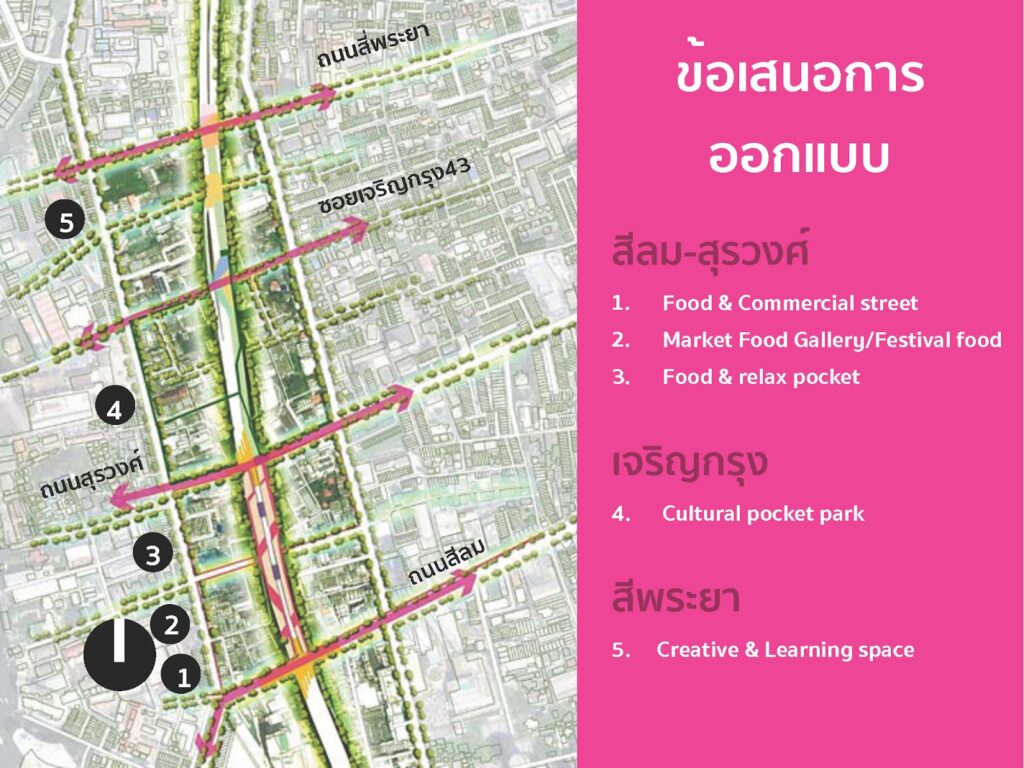
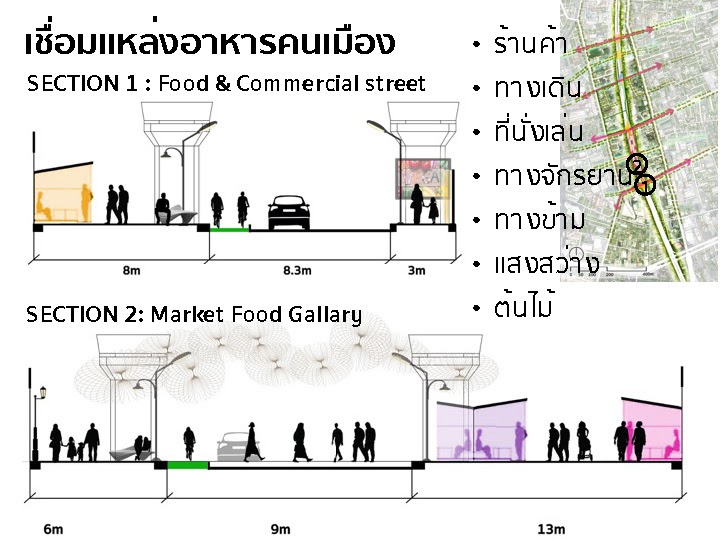
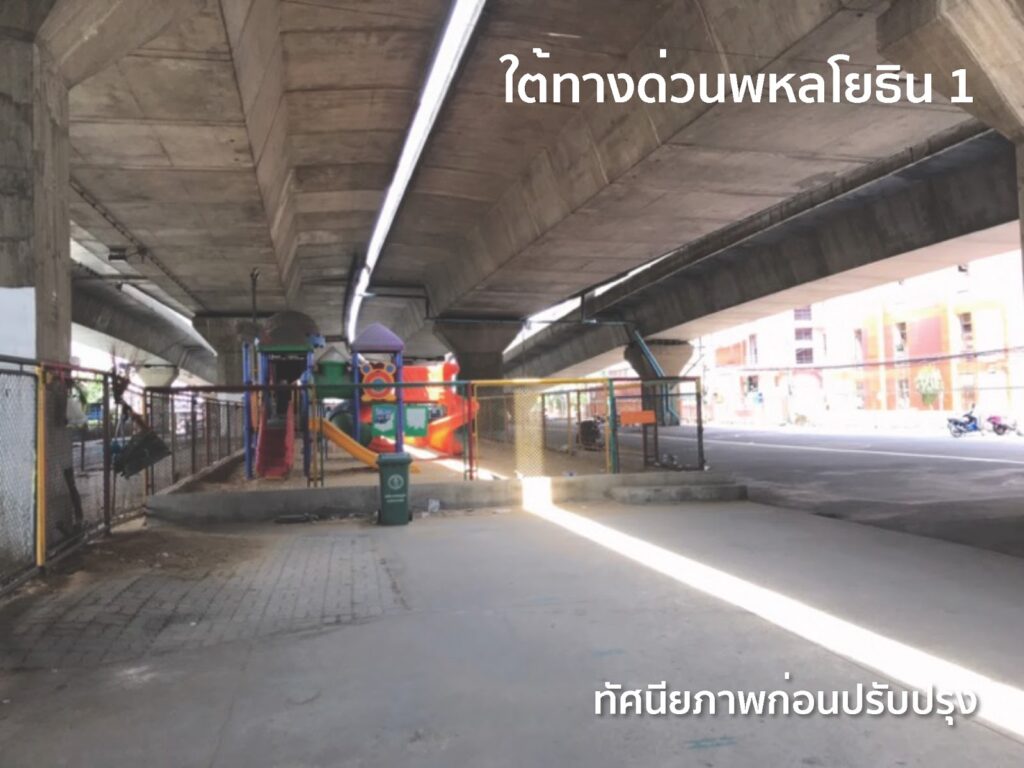

Master Plan for Urupong – Sathorn Expressway Area Development Area
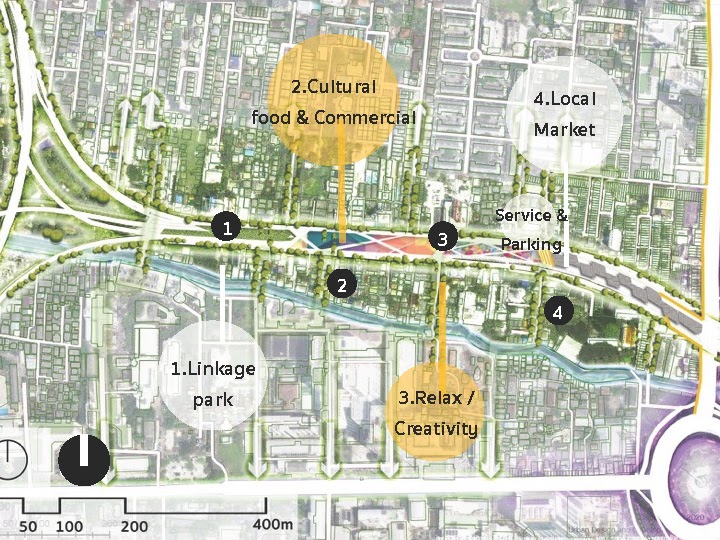
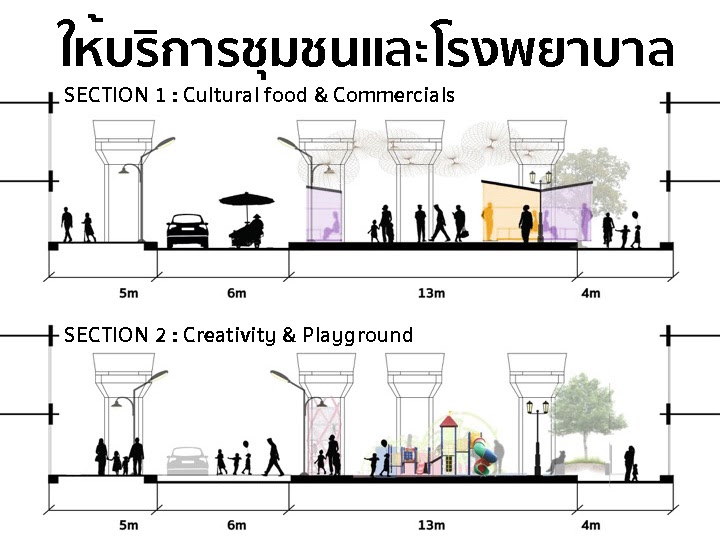
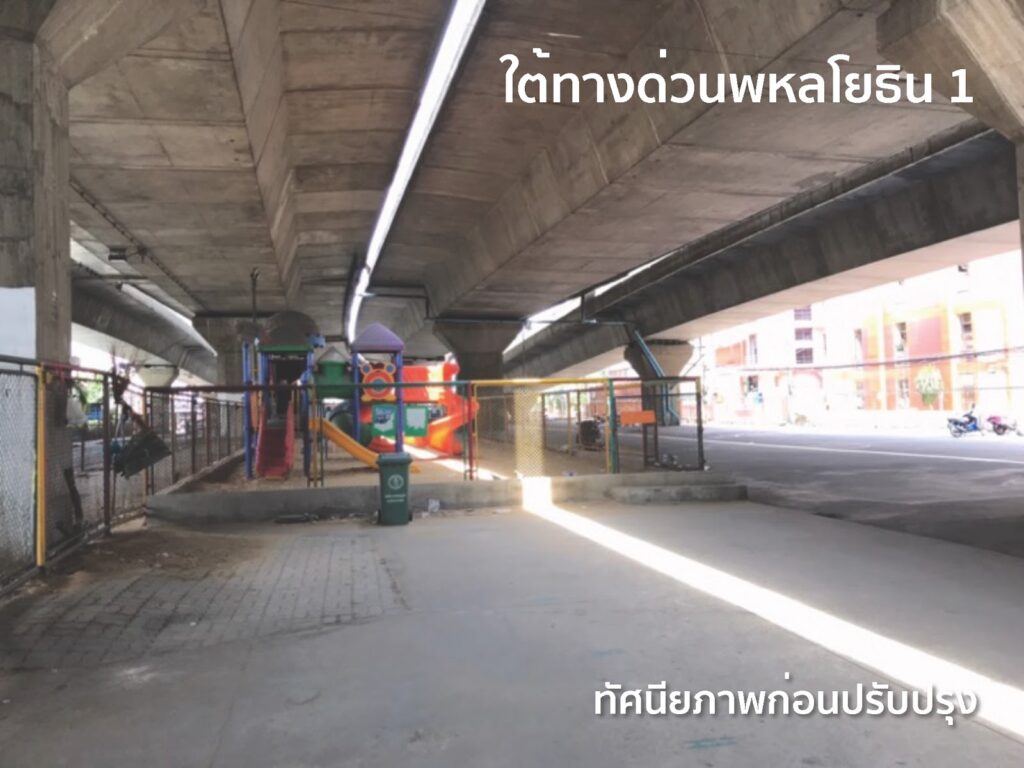
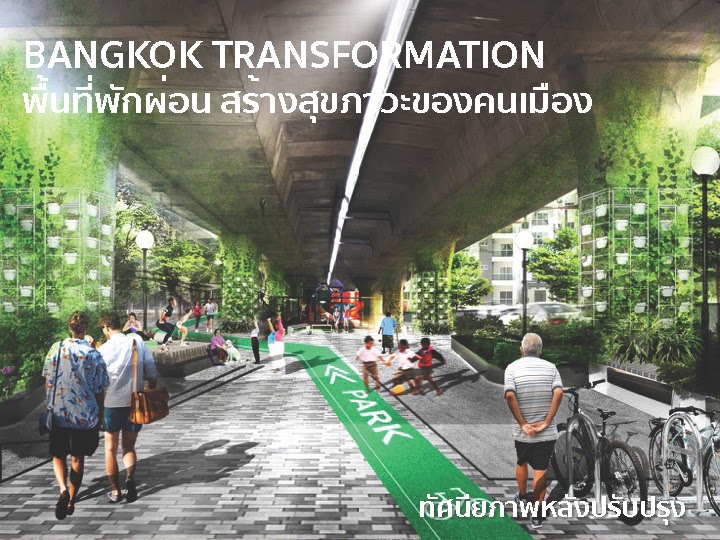
A prototype view of the area under the expressway improvement project for the Phahonyothin Soi 1 area
Principles of justice or fairness in the management of public areas of the city
In deciding the principles for designing public-space policy for roadside trade activities and fair management practices, we should start by asking the following important questions: Who is the public space of the city for? Who should take the role of manager of this space? And what role should management play to support urbanization that gives everyone fair access to benefits (Inclusive City)?
According to the economic framework, public spaces are considered a shared resource or joint property of the city. Ideally, there must be an opportunity for all citizens of the city to have access to and use without exclusion. However, we often find that, in the real world, the use of public areas of some groups may have a negative impact on many groups, such as the use of public spaces by hawkers and street vendors that may affect the rights of pedestrians and the general public. Such problems in the past have caused government agencies, who are land custodians and regulators, to enforce punitive laws against street vendors. This conflict of interests has made government officials and street vendors adversaries over a period of decades, with the community and the general public retreating as observers.
However, governance is not the burden only of government officials. In truth, the state should give an opportunity to the communities in the area, owners of various commercial building, as well as regular pedestrian users. Those entities are direct stakeholders in the hawker activity, and take part in the supervision of the area in the form of ‘block committees’ to oversee the use of specific public areas. This proposal is based on the concept of community resource governance by the Nobel Prize-winning economist Elinor Ostrom, who believes that the community has the potential to supervise and share its resources if social institutions are developed. This means strong rules and etiquette. Ostrom explains that self-management within the community creates incentives for compliance. Surveillance systems that are more effective than those controlled by external organizations, such as municipal agencies. On the other hand, enforcing rules by the state will result in less voluntary cooperation.
The next question is, what kind of rules will give people and communities the right to fair access to benefits on public spaces? On this point, we have to go back and consider the initial principles of why we allow the use of public space for commercial hawkers. Implicitly, that is because we are giving the opportunity to a group of lower-income people in the city to have a career in good faith. The hawkers and street vendors provide an economic buffer against rising cost of living for the less affluent sectors of society. In the process of setting the rules on the extent of access to public space for commercial hawker stalls, policy makers must first focus on the economic status of lower-income traders.
The next issue is the appropriate length of time granted for the right to use the public space for street trade. That deliberation requires consideration of the following:
Economic dimension: Novice traders should have a long enough opportunity to gain experience in trading, create a customer base, and accumulate enough capital to expand into the more formal system of trade.
Social and cultural dimensions: Traders should have a long enough time as street vendor to enter the social integration process. There needs to be a strategy to develop a social mechanism for monitoring and checking the behavior among merchants themselves in accordance with the Ostrom resource governance principles.
However, the duration of the right to use the public space of roadside traders should not be so long that it causes grievances that these rights belong to certain generations of people. This will lead to injustice to many others who want to access these rights. Accordingly, the rules regarding rights characteristics and duration of rights should be based on a balanced proportion between fairness, opportunity, and justice by allowing the community to participate in decisions and oversight. Such a “Committee on the Use of Specific Public Areas with Community Participation” may develop rules by specifying that the duration of the right to operate a hawker stall is 1-2 years in order to allocate new rights according to the said period. The reallocation of rights should take into account the social costs arising from the integration during the previous period. The allocation of rights should ensure that there is always a combination between the old and new groups at any one time. The proportion of rights between new and old traders may vary depending on various factors. In some communities, the street vendors may have been there for decades and across generations, who also function to support social cohesion and oversight. Giving a quota of vendor sites to older traders more than new traders is considered fair and beneficial to the social governance mechanisms. But if the commercial area is located in a trade area driven by economic mechanisms rather than social mechanisms, assigning a proportion of new traders at a level close to or greater than the old traders should be a reasonable and fair proportion according to the economic and social mechanisms in that area.
An important final point is to determine that the merchant has a net income that is appropriate for their ability to pay a fee for a right to operate a stall. The government should develop a system for fair and transparent income and local revenue collection from traders. Importantly, all of this income should be sent back to the area for cleaning, maintenance, and improving the infrastructure. This revenue rotation back to the community directly will help reduce the pressure from the negative impact of the activities of street traders, and help to promote social relations between communities to be smoother and more sustainable.
Finally, all of these proposals would not be possible if the state did not recognize the rights of communities to manage their own shared spaces. If the state expands, public spaces are considered “royal property”, not joint property of the people. Creating awareness among all parts of the public to participate in public oversight of national treasures would otherwise not have been possible. That is because people tend to be indifferent to their civic duties.
Secret weapon for urban adaptation in the post-COVID-19 era
The Urban “New Normal” after the epidemic abates is both a crisis and an opportunity to change, and create a new paradigm in city management which must reflect the cooperation of all three parties in accordance with the Triple Helix concept of government agencies. The central and local entities, the private sector, Civil Society groups, and citizen communities must jointly propose guidelines that are fair, equitable, and contribute to the sustainability of public space management, including the overall city management as well
The design guidelines and institutional management mechanisms offered by UddC are just a few examples of the use of science in design and urban development. Together, the use of urban information science, knowledge and expertise in sociology, anthropology, social work can result in synergies to solve problems and identify innovative solutions for the city. The case study here concerns the spatial management of hawker trade activities and street vendor stalls for the sake of economic benefits, job creation, and career development for lower-income members of society. With the investment of the government, cooperation of local agencies, and public understanding, this vision can be a reality.
Sources and References
Proposal from the Urban Design and Development Center (UddC-CEUS) in collaboration with the Faculty of Social Work, Thammasat University, Faculty of Architecture Rangsit University, Social Research Institute of Chulalongkorn University, the Foundation for Labor and Career Development, and the Thai Hawker Stall Network for Sustainable Development.
Announcement of the BMA on Rules, Procedures and Conditions for Establishing Commercial Areas and Sales or Selling Products in Public Places. (2020). Government Gazette, Volume 137, Special Section 47 Ngor (28 February): 17-23.
Worawan Chanchuenwit and Buntharika Chonpithakwong. (2020). Informal labor: The case of street trading. Thailand Development Research Institute
Wissanee, Poonsab, Joann Vanek and Françoise Carré. (2019). Informal Workers in Urban Thailand: A Statistical Snapshot WIEGO Statistical Brief no. 20
Hawker Stall Trading Point Database, Year 2019. (2019). Department of Law Enforcement, BMA
